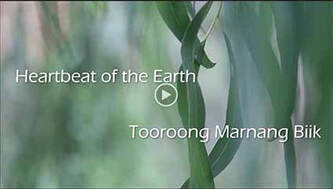 Place names give voice to Country, writes Laura Brearley, when the language is spoken and sung again.
Place names give voice to Country, writes Laura Brearley, when the language is spoken and sung again. Photos and video Terry Melvin
TERRY and I have been doing a lot of walking on beautiful Bass Coast Country during the COVID era. Terry’s been photographing and filming as we go and is in the process of making a series of short films which weave together music, images, words and natural sounds. A couple of days ago, we got up before sunrise and went to the mouth of the Powlett River, where we’ve been a few times over the last couple of months.
Yesterday, Terry uploaded his first film in the series and it features the mouth of the Powlett River, including some footage from our sunrise walk. It also includes some beautiful poetic text written and gifted by Boon Wurrung Elder Aunty Fay Stewart-Muir about Country and its transformative power. The film also includes her translation for the words ‘Heartbeat of the Earth’- ‘Tooroong Marnang Biik’ which we’ve used in the title as well as the Boon Wurrung word for Powlett River – ‘Kugerungmome’.
The local word ‘Kugerungmome’ for Powlett River can found in the Dictionary of Aboriginal Placenames of Melbourne and Central Victoria compiled by Ian D Clark & Toby Heyson 2002, and published by the Victorian Aboriginal Corporation for Languages. It’s also in the Wikipedia entry for Powlett River where the source of the language name is referenced as: "Powlett River: 23828: Traditional Name: Kugerungmome". Vicnames. Government of Victoria. 2 May 1966.
I wanted to learn more about how the Powlett River got its name. Here is an excerpt from the Wikipedia entry for Frederick Powlett: “‘The Powlett River was named in 1841 in his honour after an arrest at this place of two (Aboriginal) men, Tunnerminnerwait (known as Jack) and Maulboyheenner (known as Bob, or sometimes called Timmy or Jimmy), who became the first people executed in the Port Phillip District.”
Frederick Powlett was the Commissioner of the District of Western Port at the time.
The stories of Tunnerminnerwait and Maulboyheenner have been a significant focus of the Bass Coast/South Gippsland Reconciliation Group over recent years but the information that Frederick Powlett was involved in their arrest and that a river in our region had been named “in his honour” was new to me. It led me to go deeper in my research. It’s a distressing read, so please take care if you choose to have a look, but the details of Tunnerminnerwait and Maulboyheenner’s capture are in this document http://www.anarchistmedia.org/pdf/The-Tunner-Maulboy-Booklet.pdf p.18-20.
Here we are in Reconciliation Week and it’s a good time to be thinking about the restorative practice of returning places to their original names as part of a longer, broader healing process.
It’s a wonderful thing to see the way that the word Millowl is being increasingly used for Phillip Island. I applaud the work of Sonia Weston, Cr. Geoff Ellis, Dr Marg Lynn and many others who recognise the significance of a name and who worked so hard and for so long to get the McMillan name dropped from our electorate.
There are 3400 names of places in Clark and Heyson’s Dictionary of Aboriginal Placenames. They retrieved the place names from 19th century journals, combined with modern linguistic analysis. Their research reveals that Aboriginal placenames refer to specific ancestral stories and that the cultural heritage of a place resides in its name. Place names, they believe, are an important component of Aboriginal cultural heritage “presenting and describing relationships with land and Country”.
Here are some of their entries for place names in the Bass Coast region.
Anderson Inlet
Bubinorer Boonwurrung
Toluncan Boonwurrung
Cape Woolamai
Wollamai Word for snapper in Dharuk language of the Eora people, Sydney. Bass, who had learnt some of the language from the Eora leader, Bennelong, thought the headland resembled the head of that fish.
Source: R. M. W. Dixon 1990, Australian Aboriginal words in English, Oxford University Press.
French Island
Bawal Boonwurrung
Jouap Boonwurrung
Koo-wee-rup
Kuwirap Boonwurrung
Wirap - blackfish Boonwurrung
Place names give voice to Country. Aunty Fay Stewart-Muir tells us that the Country comes alive when the language is spoken and sung again. There are respectful protocols to follow and Aunty Fay, a senior language specialist at the Victorian Aboriginal Corporation for Languages, is generous with teaching these. In her words: “Language is central to understanding and celebrating culture. We love to hear Aboriginal languages being spoken and sung once again. So does the Country.”
And so … here are links to Terry’s new film which features Aunty Fay’s words and the beauty and power of Kugerungmome:
https://vimeo.com/422690365
https://youtu.be/qBU1KCb4q3g
National Reconciliation Week runs from May 27 to June 3.